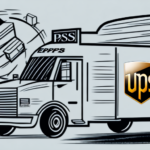Comparing International Shipping Rates for UPS and FedEx
Shipping products internationally has become increasingly common in today’s global economy, with e-commerce enabling businesses of all sizes to reach customers worldwide. According to recent statistics, the global e-commerce market is expected to reach trillions in value by 2025. Whether you own a small business or are sending a one-time shipment, it’s crucial to choose the right carrier to meet your specific needs. UPS and FedEx are two of the largest shipping companies in the world, both offering a wide range of services tailored for international shipping.
Introduction to International Shipping with UPS and FedEx
International shipping can be daunting, with varying customs regulations, diverse delivery options, and fluctuating shipping rates. Understanding the nuances of shipping internationally with UPS and FedEx is essential for ensuring smooth and cost-effective deliveries. In this article, we will provide an in-depth analysis of the different shipping services offered by both carriers, calculate associated costs, and compare key factors such as transit times, delivery options, customs clearance processes, and tracking capabilities. By the end of this guide, you’ll have the insights needed to make an informed decision tailored to your international shipping needs.
One of the key factors to consider when shipping internationally is the packaging of your items. Both UPS and FedEx have specific guidelines for packaging, which can affect the safety and security of your shipment. It’s important to choose the right packaging materials and ensure that your items are properly secured to prevent damage during transit.
Another important consideration is the documentation required for international shipping. This can include customs forms, commercial invoices, and other paperwork. UPS and FedEx both offer online tools and resources to help you prepare and submit the necessary documentation, but it’s important to understand the requirements for your specific shipment and destination country.
Understanding the Different Shipping Services Offered by UPS and FedEx
Both UPS and FedEx offer a range of international shipping services. UPS provides a host of options including UPS Worldwide Express Plus, UPS Worldwide Express, UPS Worldwide Expedited, and UPS Standard. FedEx offers a similar range of services with FedEx International Priority, FedEx International First, FedEx International Economy, and FedEx International Ground.
UPS Worldwide Express Plus offers the fastest delivery times, with packages guaranteed to arrive the next business day before noon. UPS Worldwide Express and FedEx International Priority provide guaranteed delivery within 1-3 business days. Both carriers’ economy services, such as UPS Standard and FedEx International Economy, are slower but offer the most cost-effective options for international shipments.
It is important to note that both UPS and FedEx offer additional services such as customs clearance, insurance, and package tracking. These services can be especially helpful for businesses shipping internationally. UPS My Choice allows customers to customize their delivery preferences and receive alerts about their package status. Similarly, FedEx Delivery Manager provides comparable features. It is important to research and compare the additional services offered by both carriers to determine which one best fits your shipping needs.
Factors Affecting International Shipping Rates for UPS and FedEx
When calculating international shipping rates, several factors come into play. The size and weight of your package, the destination country, mode of transportation, and the type of service you choose all significantly impact your shipping costs. According to the Statista report, dimensional weight pricing can increase costs for larger, lightweight packages, emphasizing the importance of optimizing package dimensions.
Both carriers provide online calculators to estimate shipping costs. These tools consider the package weight and dimensions, destination, and selected service to provide accurate estimates. However, keep in mind that additional fees such as customs duties and taxes, fuel surcharges, and remote area surcharges may apply, potentially increasing the total shipping cost.
It's important to note that shipping rates for UPS and FedEx can fluctuate based on the time of year and prevailing market conditions. During peak seasons, such as the holiday season, shipping rates often increase due to high demand. According to a UPS pricing report, rates can surge by up to 15% during these periods. Additionally, disruptions in the global supply chain, caused by natural disasters, political unrest, or economic shifts, can also lead to variances in shipping costs.
How to Calculate Shipping Costs for UPS and FedEx Shipments
Calculating shipping costs is essential for any budget-conscious individual or business. Start by measuring the dimensions of your package and obtaining an accurate weight. Next, enter the package details into the UPS online cost calculator or the FedEx online cost calculator. These calculators will provide an estimate of the shipping cost based on the selected shipping service and destination destination.
Alternatively, you can arrange for a courier to collect the package from your location and handle the weighing and labeling process. If you prefer to drop off the package in person, you can visit any UPS drop-off point or FedEx drop-off location to complete the shipment process.
It is important to note that the shipping cost may vary depending on the type of service you choose. For example, if you need your package to be delivered urgently, you may have to pay a higher shipping cost for expedited or overnight delivery. On the other hand, if you are not in a rush, you can opt for standard shipping, which is usually less expensive. According to FedEx shipping tools, selecting the appropriate service level can optimize both cost and delivery speed.
Another factor that can affect the shipping cost is the destination of your package. Shipping to a remote or international location may cost more than shipping within the same country or region. For instance, shipping to developing countries can incur higher rates due to less infrastructure and higher risks. It is advisable to check the shipping rates for different destinations to ensure cost-effectiveness before finalizing your shipment.
Comparing Transit Times for International Shipments with UPS and FedEx
Transit time is a critical factor in international shipping, influencing both the overall cost and customer satisfaction. Faster delivery typically comes at a higher price, so balancing speed and cost is essential. Both UPS and FedEx offer similar transit times for their respective expedited international services, catering to varying delivery speed requirements.
UPS Worldwide Express and FedEx International Priority both offer guaranteed delivery times of 1-3 business days for international shipments, ensuring swift delivery for urgent packages. Conversely, their economy services, such as UPS Standard and FedEx International Economy, typically have longer transit times ranging from 4-6 business days. Understanding these transit times can help you make informed decisions and effectively plan your shipments based on delivery urgency.
It's important to note that transit times can vary based on the destination country and the customs clearance process. Some countries have stricter customs regulations, which can lead to delays in delivery. Additionally, weather conditions, natural disasters, and other unforeseen circumstances can also impact transit times. To mitigate these risks, it's always a good idea to track your shipments and maintain communication with your carrier to ensure timely delivery.
Differences in Delivery Options Offered by UPS and FedEx for International Shipments
Both UPS and FedEx offer a variety of delivery options, including door-to-door delivery, delivery to a pickup location, and delivery to a customer’s business or residence. Shipments destined for addresses outside normal delivery areas may incur additional costs, such as remote area surcharges. It’s advisable to check with the carrier for any extra fees associated with your delivery location.
UPS Hold for Pickup offers the option to hold packages at a UPS warehouse for recipient pickup. This feature is particularly useful if the recipient is unavailable to accept delivery or prefers to collect the package directly, ensuring convenience and flexibility in receiving shipments.
Conversely, FedEx Delivery Manager allows customers to customize their delivery preferences, including scheduling a delivery time, requesting a different delivery address, or having the package held for pickup at a FedEx location. Additionally, FedEx offers a money-back guarantee for its international shipments, ensuring that customers are eligible for a refund of shipping costs if a package is not delivered on time.
Comparing Customs Clearance Processes for International Shipments with UPS and FedEx
Customs clearance is a crucial aspect of international shipping, ensuring that packages comply with the import and export regulations of both the originating and destination countries. Both UPS and FedEx provide comprehensive customs clearance services, which include the completion of necessary customs paperwork, payment of duties and taxes, and ensuring final delivery to the recipient.
While both carriers adhere to strict customs regulations to facilitate smooth international shipments, UPS offers a more extensive customs brokerage service compared to FedEx. This enhanced service enables faster and more efficient customs clearance, reducing potential delays and ensuring timely delivery.
In addition to standard customs clearance services, both carriers offer specialized solutions for specific shipping needs. UPS Worldwide Express Freight provides fast and reliable shipping for large and heavy items, catering to businesses with bulk shipping requirements. Similarly, FedEx International Priority Freight offers expedited shipping options for significant shipments, ensuring timely and secure delivery for heavy and oversized packages.
Another key difference between UPS and FedEx lies in their pricing structures for international shipping rates. UPS offers a variety of pricing options, including flat rate pricing for certain shipments and negotiated rates for high-volume shippers, providing cost predictability and potential savings for frequent users. In contrast, FedEx primarily utilizes dynamic pricing, which is determined based on the weight and dimensions of the package, the destination, and the chosen shipping speed. This approach can offer competitive pricing for smaller or less frequent shipments.
Dealing with Customs Duties, Taxes, and Fees When Shipping Internationally with UPS and FedEx
Customs duties, taxes, and fees are additional charges that may be applied to your international shipments, varying based on the destination country and the type of product being shipped. Both UPS and FedEx provide estimates of these charges upfront using their respective shipping calculators. It's crucial to factor these fees into your overall shipping costs to avoid unexpected expenses upon delivery.
Customs duties, taxes, and fees can vary significantly between countries, with some nations imposing higher import taxes and others enforcing specific restrictions on certain products. Before shipping, it's advisable to research the regulations and fees applicable to your destination country and product category to ensure compliance and cost management. Both UPS and FedEx offer customs brokerage services to assist in navigating the complexities of international shipping and customs clearance, thereby streamlining the process and minimizing potential delays or additional costs.
Tracking Your International Shipment with UPS and FedEx
Both UPS and FedEx provide comprehensive tracking options for international shipments. Utilizing the unique tracking numbers provided at the time of shipment, you can monitor your package's progress from pickup to final delivery. These carriers also offer updated information regarding customs clearance time frames, facilitating better planning and anticipation of delivery schedules.
In addition to tracking and customs clearance updates, both carriers offer insurance options for international shipments. These insurance plans provide protection against unexpected damages or losses that may occur during transit, offering peace of mind to shippers. It's important to carefully review the UPS insurance options and FedEx insurance options, including their coverage limits and terms, to select a plan that best aligns with your shipment's value and your specific needs.
How to Choose Between UPS and FedEx for Your International Shipping Needs
Choosing between UPS and FedEx for your international shipping needs depends on several factors, including the urgency, size, and frequency of your shipments. If timely delivery is paramount, both carriers provide expedited services to ensure swift arrival. UPS offers a more comprehensive range of customs clearance services compared to FedEx, though this often comes at a higher cost. Conversely, FedEx tends to be more cost-effective for lightweight and non-time-sensitive shipments, making it a suitable choice for businesses looking to minimize shipping expenses without compromising reliability.
Tips to Save Money on International Shipping Rates with UPS and FedEx
To save money on international shipping rates with UPS and FedEx, consider the following strategies:
- Consolidate Shipments: Combine multiple shipments into one larger package to take advantage of bulk shipping rates and reduce overall costs.
- Opt for Economy Services: Use slower economy services when delivery time is not a critical factor, as these options are generally more cost-effective.
- Ship During Off-Peak Times: Avoid peak shipping seasons, such as the holiday period, to benefit from lower shipping rates and more reliable transit times.
- Leverage Volume Discounts: Take advantage of volume-based discounts by increasing your shipping frequency or partnering with a shipping aggregator to negotiate better rates.
Implementing these tips can help you reduce your international shipping expenses while maintaining efficient delivery schedules.
Conclusion: Which One is Better - UPS or FedEx?
Both UPS and FedEx offer a comprehensive array of international shipping services tailored to meet diverse shipping needs. The optimal choice between the two will ultimately depend on your specific requirements, such as delivery speed, package size, budget constraints, and the importance of additional services like customs brokerage. By thoroughly understanding the differences in services, transit times, delivery options, customs clearance processes, fees, and tracking capabilities, you can make an informed decision on which carrier best aligns with your international shipping objectives. Remember to regularly compare rates and explore available cost-saving opportunities to maximize your shipping efficiency and budget.




















